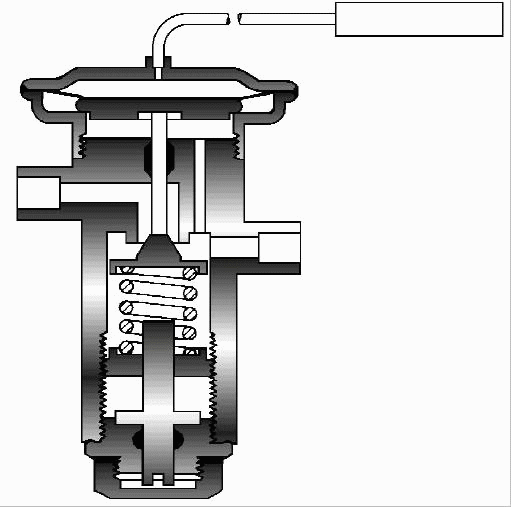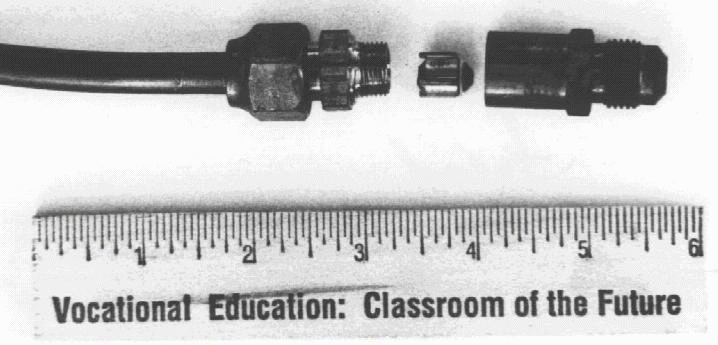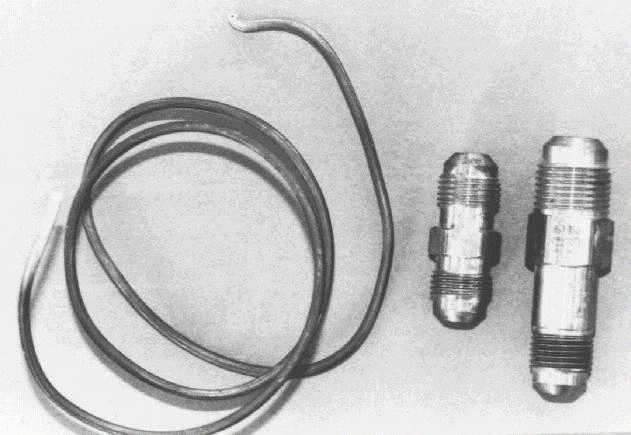TXV BLUES
(Thermostatic Expansion Valve)
- GOAL:
- Show the impact of the thermostatic expansion valve (TXV) on energy consumption.
- OBJECTIVES:
- The student will be able to:
- 1. Illustrate the operation of a TXV.
- 2. Discuss the positive and negative impacts that valve sizing and adjustments have on energy consumption.
- LESSON / INFORMATION:
- The thermostatic expansion valve (TXV) (see Figure 1) was removed from production by most manufacturers during the seventies and early eighties due to cost savings in production.
- Figure 1a.

- Figure 1b.

- In the late 1980s, we saw a resurgence of TXV use as energy consumption became an important issue. There are two basic metering devices for refrigeration. A fixed type and a modulating type. The fixed type used in the HVAC industry would be a capillary tube (see Figure 2) or a metering piston (see Figure 3). The modulating or regulating type would be the TXV.
- Figure 2.

- Figure 3.

- Adjustment of the thermostatic expansion valve is very important. The valve setting is determined by the amount of superheat in the refrigerant gas. Superheat is the temperature of the refrigerant gas above the temperature given by the pressure and temperature chart for the specific pressure. In air conditioning, most valves are set to 10°F superheat. The superheat determines the amount of liquid refrigerant mixed in the return gas. Too little superheat will cause the liquid refrigerant to damage the compressor. Too much superheat will cause poor evaporator coil performance and compressor overheating.
- Proper valve sizing is also important. The valve capacity should be matched to the outdoor unit capacity. A valve that is too small will starve the outdoor coil or refrigerant and a valve that is too large will flood the compressor with refrigerant. All valves are rated in tonnage with 100 psig pressure drop across the valve. The higher the pressure drop, the more capacity the valve has. The lower the pressure drop, the lower the capacity.
- ACTIVITY 1: Multiple Choice
- _____ 1. TXV is the abbreviation for:
- a. thermic expansion valve
- b. thermometer expansion valve
- c. thermostatic expansion valve
- _____ 2. TXVs were removed from the market to:
- a. save energy use by the unit
- b. save on production costs of the unit
- c. new laws made it no longer required on the unit.
- _____ 3. Resurgence of use of the TXV began in:
- a. late 1970s
- b. early 1980s
- c. late 1980s
- d. early 1990s
- _____ 4. There is/are ______ basic type(s) of metering system(s) for refrigeration.
- a. 1
- b. 2
- c. 3
- d. 4
- _____ 5. The modulating type of metering device would be the:
- a. thermostatic expansion valve (TXV)
- b. capillary tube
- c. metering piston
- d. refrigerant tube valve
- e. energy consumption valve
- The TXV has many advantages over the fixed type. The first would be its capability to regulate refrigerant flow over a wide range of load conditions, and the second would be its ability to shut off refrigerant flow when the compressor stops.
- A bleed port valve cannot accomplish the second task and that is why it is critical to put the correct valve in service.
- Because the TXV can increase or decrease refrigerant flow according to load, it can raise or lower the amount of energy used by the compressor. Another benefit is that it can control the temperature of the compressor and keep it in a closer range through a wide load variance. Both of these are great benefits for energy consumption and compressor life. Also, the 100% shut-off valve can increase SEER by up to .50 because the liquid line is pressurized and ready to supply liquid to the valve the moment the compressor starts. This increase can be seen in the examples on the next two pages. Note the SEER of the TTX042 with the same evaporator coil, but using a fixed orifice, a bleed type TXV, and 100% shut-off valve.
- **** Note: The follwing charts represent two pages from the ARI Directory. Due to the large sizes of the examples each page has been broken up into two charts. ****
- *****Pick here for Pages AC-289 & AC-290 of
the ARI Directory*****
Pages AC-289 & AC-290 of the ARI Directory, August 1, 1992 - January 31, 1993, reprinted by courtesy of Air-Conditioning and Refrigeration Institute, (ARI).
- INFORMATION CHECK
- 1. List at least two advantages of the TXV over the other metering device options.
- a.
- b.
- 2. In your own words, describe how use of a TXV valve has a positive effect on energy consumption.
- TEACHER'S NOTES
- ACTIVITY 1:
- 1. c
- 2. b
- 3. c
- 4. b
- 5. a
- INFORMATION CHECK:
- 1a. The TXV has the ability to regulate refrigerant flow over a wide range of load conditions.
- 1b. The TXV has the ability to shut off refrigerant flow when the compressor stops.
- 2. (Students' answers will vary) The TXV can help save on energy by adjusting refrigerant flow according to load. It can thus reduce the amount of energy used by the compressor. The TXV can also control the temperature of the compressor and keep its variance low through a wide range of changes in load.
- REFERENCES:
- Directory of Certified Unitary Air-Conditioners (Section AC), Unitary Air-Source Heat Pumps (Section HP) and Sound-Rated Outdoor Unitary Equipment. Air-Conditioning & Refrigeration Institute, Arlington, VA. 1992.
Comments or questions to: TechAsmt@LA.GOV
Return to HVAC Menu







